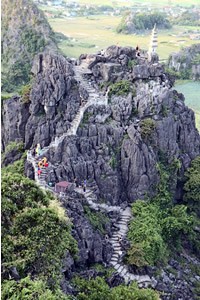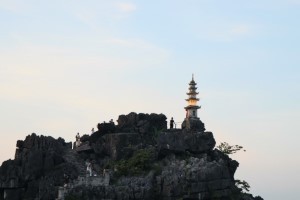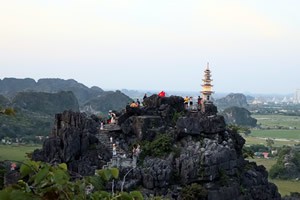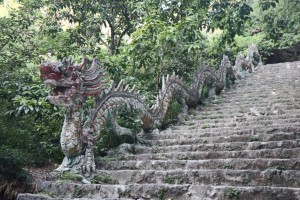Are you planning a trip to Ninh Binh and wondering about the crowds at Hang Mua? This popular destination, known for its stunning panoramic views, can get busy. SIXT.VN offers you insights into the best times to visit Hang Mua and how to avoid the crowds, ensuring you have an unforgettable experience of Vietnam’s natural beauty. We’ll also help you explore alternative viewpoints and provide tips for a smooth and enjoyable trip, ensuring your visit is both memorable and stress-free, enhancing your cultural tourism and landscape photography opportunities.
1. Understanding Hang Mua’s Appeal
Hang Mua, often called the Mua Cave, is a must-see attraction in Ninh Binh, Vietnam, drawing visitors with its breathtaking panoramic views of the surrounding landscape. The climb to the top involves ascending approximately 500 stone steps, a journey that is both challenging and rewarding, culminating in stunning vistas of Tam Coc’s rice paddies and the karst mountains that define the region. The allure of Hang Mua lies in its unique blend of natural beauty and historical significance, making it a favorite spot for tourists seeking both adventure and picturesque scenery. Its popularity, however, means that it can get quite crowded, especially during peak times.
1.1. Why is Hang Mua so popular?
Hang Mua’s popularity stems from a combination of factors. It offers unparalleled views of the Tam Coc region, often referred to as “Ha Long Bay on land.” The iconic dragon statue at the summit provides a dramatic backdrop for photos, and the relatively easy access compared to other viewpoints in the area makes it appealing to a wide range of travelers. Additionally, Hang Mua’s historical significance, linked to the Tran Dynasty, adds a layer of cultural interest to the experience. The stunning panoramic views, especially during sunrise and sunset, are heavily promoted on social media, drawing a large influx of tourists eager to capture their own memorable shots.
 View from Hang Mua Peak Ninh Binh
View from Hang Mua Peak Ninh Binh
1.2. Peak Season vs. Off-Season at Hang Mua
The best time to visit Hang Mua depends on your tolerance for crowds and your preference for weather conditions. Peak season in Ninh Binh typically falls between October and April, when the weather is drier and cooler. This also coincides with major holidays and school breaks, leading to increased tourist traffic. Conversely, the off-season, from May to September, experiences higher rainfall and humidity, which may deter some visitors. However, the off-season offers the advantage of fewer crowds and potentially lower prices for accommodation and tours. The shoulder seasons (April-May and September-October) can offer a balance of pleasant weather and manageable crowds. According to the Vietnam National Administration of Tourism, the peak season sees a 40% increase in tourist arrivals compared to the off-season.
Table: Peak Season vs Off Season at Hang Mua
| Feature | Peak Season (October – April) | Off-Season (May – September) |
|---|---|---|
| Weather | Drier and cooler | Higher rainfall and humidity |
| Crowds | More crowded | Fewer crowds |
| Prices | Higher prices | Potentially lower prices |
| Best for | Pleasant weather | Budget travelers, avoiding crowds |
| Tourist Volume | 40% Increase |
2. Is Hang Mua Crowded at Sunrise/Sunset?
Yes, Hang Mua is often very crowded at sunrise and sunset due to the stunning panoramic views. These are the most popular times to visit, attracting many tourists hoping to capture the perfect photograph.
2.1. The Allure of Sunrise and Sunset at Hang Mua
Sunrise and sunset at Hang Mua offer a truly magical experience. As the sun rises or sets, the landscape is bathed in a golden light, creating a breathtaking spectacle of colors across the rice paddies and limestone karsts. The soft, diffused light is ideal for photography, and the cooler temperatures make the climb more comfortable. Many visitors find the experience to be deeply spiritual, connecting with the natural beauty of the region. However, the popularity of these times means that you’ll be sharing the experience with many other people. According to TripAdvisor reviews, sunrise and sunset are consistently rated as the best times to visit Hang Mua for the scenery.
2.2. Crowd Levels at Sunrise
At sunrise, Hang Mua tends to be less crowded than at sunset, but it’s still a popular time. Many serious photographers and early risers aim to arrive before dawn to secure the best spots for capturing the sunrise. While you won’t have the summit to yourself, the crowds are generally more manageable, allowing for a more peaceful experience. Expect to encounter tour groups and individual travelers, but the atmosphere is usually calm and respectful as everyone waits for the sun to rise. Getting there early, around 5:00 AM to 5:30 AM, is advisable to secure a good viewing spot and avoid the worst of the rush.
2.3. Crowd Levels at Sunset
Sunset at Hang Mua is typically the most crowded time of day. Tour groups often schedule their visits to coincide with sunset, and many independent travelers also flock to the summit to witness the spectacle. The viewing platforms can become very congested, making it difficult to move around and find a good vantage point. Expect long queues at the entrance and on the stairs, and be prepared to share your space with many other people. While the sunset views are undeniably stunning, the crowds can detract from the overall experience. Arriving at least an hour before sunset is recommended, but even then, be prepared for a busy and potentially chaotic atmosphere.
 Hang Mua at Dusk – Ninh Binh Vietnam
Hang Mua at Dusk – Ninh Binh Vietnam
3. How to Avoid the Crowds at Hang Mua
Avoiding the crowds at Hang Mua requires strategic planning and a willingness to deviate from the most popular times. By considering alternative times of day, exploring different routes, and utilizing local knowledge, you can significantly enhance your experience and enjoy the beauty of Hang Mua without the stress of large crowds.
3.1. Visiting During Off-Peak Hours
One of the most effective ways to avoid the crowds at Hang Mua is to visit during off-peak hours. Consider visiting in the mid-morning (9:00 AM – 11:00 AM) or mid-afternoon (2:00 PM – 4:00 PM). These times typically see fewer tour groups and independent travelers, allowing you to enjoy a more peaceful and relaxed experience. While the light may not be as dramatic as at sunrise or sunset, the panoramic views are still breathtaking, and you’ll have more space to explore and take photos. Be aware that the midday sun can be intense, so be sure to wear sunscreen, a hat, and sunglasses, and bring plenty of water.
3.2. Exploring on Weekdays
Weekends and public holidays are the busiest times at Hang Mua. If possible, plan your visit for a weekday, such as a Tuesday or Wednesday. Weekday crowds are generally smaller, and you’ll have a better chance of enjoying a more intimate experience. Local residents and domestic tourists are more likely to visit on weekends, so avoiding these days can significantly reduce the number of people you encounter. Check the Vietnamese public holiday calendar before planning your trip to avoid any unexpected surges in tourist traffic.
3.3. Alternative Routes and Viewpoints
While the main route to the Hang Mua summit is the most popular, there are alternative viewpoints and routes that offer equally stunning views with fewer crowds. Consider exploring the surrounding area and discovering hidden gems that are off the beaten path. Local guides can provide valuable insights into these alternative routes and viewpoints. Researching lesser-known trails and viewpoints can lead to a more unique and rewarding experience. Some nearby hills offer similar panoramic views without the crowds of Hang Mua.
3.4. Hiring a Local Guide
Hiring a local guide can be a valuable investment for your visit to Hang Mua. Local guides possess in-depth knowledge of the area and can provide insights into the best times to visit, alternative routes, and hidden viewpoints. They can also share local stories and cultural information, enriching your experience beyond the typical tourist itinerary. A local guide can help you navigate the crowds and ensure that you make the most of your visit. They can also assist with transportation and translation, making your trip more convenient and enjoyable.
4. What to Expect During Your Visit
Planning your visit to Hang Mua involves more than just avoiding the crowds. Understanding the physical demands of the climb, the facilities available, and the cultural etiquette will help you prepare for a smooth and enjoyable experience. Knowing what to expect will allow you to focus on the beauty of the landscape and the cultural significance of the site.
4.1. The Climb to the Top
The climb to the top of Hang Mua involves ascending approximately 500 stone steps. The steps are uneven and can be steep in places, making the climb moderately challenging. It’s important to wear comfortable shoes with good traction and to pace yourself. Allow plenty of time for the climb, especially if you’re not used to physical activity. There are several rest stops along the way where you can catch your breath and enjoy the views. Be sure to bring water to stay hydrated, especially on hot days. The climb can take anywhere from 30 minutes to an hour, depending on your fitness level.
4.2. Facilities and Amenities
At the base of Hang Mua, you’ll find a range of facilities and amenities, including restaurants, cafes, souvenir shops, and restrooms. There is also a parking area for motorbikes and bicycles. The entrance fee to Hang Mua is 100,000 VND per person. Once inside, there are no facilities on the way to the summit, so be sure to use the restrooms and purchase any supplies you need before starting the climb. Some vendors sell water and snacks along the route, but it’s best to bring your own to avoid inflated prices.
4.3. Cultural Etiquette
Hang Mua is a place of cultural and historical significance, so it’s important to be respectful during your visit. Dress modestly, avoiding revealing clothing. Remove your shoes when entering temples or other religious sites. Speak quietly and avoid making excessive noise. Be mindful of other visitors and avoid blocking their views or taking up too much space. Ask for permission before taking photos of local people. By following these simple guidelines, you can help preserve the cultural integrity of Hang Mua and show respect for the local community.
 Mua Cave Temple at the summit
Mua Cave Temple at the summit
5. Alternative Activities in Ninh Binh
Ninh Binh offers a wealth of attractions beyond Hang Mua, allowing you to diversify your itinerary and discover the region’s natural and cultural treasures. From boat tours through stunning cave systems to exploring ancient temples and pagodas, there’s something for everyone in Ninh Binh. By exploring these alternative activities, you can create a more well-rounded and enriching travel experience.
5.1. Tam Coc Boat Tour
A Tam Coc boat tour is a quintessential Ninh Binh experience. You’ll be rowed along the Ngo Dong River through three stunning caves – Hang Ca, Hang Hai, and Hang Ba – surrounded by towering limestone karsts and lush rice paddies. The boat ride typically lasts around two hours and offers a unique perspective on the landscape. Be prepared for the boat rowers to ask for tips at the end of the tour. Wearing a hat and sunscreen is recommended, as there is little shade on the river.
5.2. Trang An Scenic Landscape Complex
The Trang An Scenic Landscape Complex is a UNESCO World Heritage Site and a must-visit destination in Ninh Binh. Similar to Tam Coc, Trang An offers boat tours through a network of interconnected caves and waterways, surrounded by dramatic limestone cliffs and dense forests. The Trang An boat tours are longer and more extensive than those in Tam Coc, offering a deeper exploration of the region’s natural beauty. There are several different boat routes to choose from, each offering a unique experience.
5.3. Bai Dinh Pagoda
Bai Dinh Pagoda is one of the largest Buddhist complexes in Southeast Asia, featuring impressive temples, halls, and statues. The pagoda is a relatively new construction, but it’s built on the site of an ancient temple and is a significant pilgrimage destination for Vietnamese Buddhists. Exploring the vast complex can take several hours, so wear comfortable shoes and be prepared for a lot of walking. The pagoda offers stunning views of the surrounding countryside.
5.4. Hoa Lu Ancient Capital
Hoa Lu was the ancient capital of Vietnam during the Dinh and Le dynasties in the 10th and 11th centuries. Today, the site is home to well-preserved temples dedicated to these former emperors, offering a glimpse into Vietnam’s rich history. Exploring the ancient capital is a fascinating journey back in time. The temples are surrounded by picturesque rice paddies and limestone hills.
6. Planning Your Trip with SIXT.VN
Planning a trip to Ninh Binh can be overwhelming, but SIXT.VN is here to help you create a seamless and unforgettable experience. From airport transfers to hotel bookings and guided tours, we offer a comprehensive range of services to meet your travel needs. Let us take the stress out of planning so you can focus on enjoying the beauty and culture of Ninh Binh.
6.1. Convenient Airport Transfers
Start your trip off right with a convenient and reliable airport transfer from SIXT.VN. We offer a range of vehicles to suit your needs, from private cars to larger vans for groups. Our professional drivers will meet you at the airport and transport you directly to your hotel in Ninh Binh, ensuring a smooth and hassle-free arrival. Booking your airport transfer in advance through SIXT.VN guarantees a fixed price and avoids the uncertainty of negotiating with local taxis.
6.2. Handpicked Hotel Selection
Finding the perfect accommodation is essential for a comfortable and enjoyable trip. SIXT.VN offers a handpicked selection of hotels in Ninh Binh, ranging from budget-friendly guesthouses to luxurious resorts. We carefully vet each property to ensure that it meets our high standards for quality, service, and location. Whether you’re looking for a cozy retreat in the countryside or a centrally located hotel in Tam Coc, we have the perfect option for you.
6.3. Expertly Guided Tours
Discover the best of Ninh Binh with our expertly guided tours. Our knowledgeable local guides will take you to the region’s most iconic attractions and hidden gems, providing insights into the history, culture, and natural beauty of the area. We offer a range of tour options to suit your interests and preferences, from half-day excursions to multi-day adventures. Let us handle the logistics while you sit back and enjoy the ride.
6.4. Customized Travel Packages
Create your dream trip to Ninh Binh with our customized travel packages. Tell us your interests, budget, and travel dates, and we’ll create a personalized itinerary that’s tailored to your specific needs. Our travel experts will handle all the details, from flights and accommodation to tours and activities. With SIXT.VN, you can relax and enjoy a stress-free vacation knowing that everything is taken care of.
 Dragon Staircase at Hang Mua
Dragon Staircase at Hang Mua
7. Tips for a Memorable Visit
To ensure a memorable and enjoyable visit to Hang Mua, consider these additional tips. From packing essentials to staying connected, these practical suggestions will help you prepare for a smooth and fulfilling experience.
7.1. What to Pack
Packing appropriately for your trip to Hang Mua is essential for comfort and safety. Be sure to bring comfortable walking shoes, sunscreen, a hat, sunglasses, and insect repellent. Lightweight, breathable clothing is recommended, especially during the warmer months. A rain jacket or umbrella is a good idea, especially if you’re visiting during the rainy season. Don’t forget your camera to capture the stunning views.
7.2. Staying Connected
Staying connected during your trip to Ninh Binh can be helpful for navigation, communication, and accessing information. Consider purchasing a local SIM card or renting a portable Wi-Fi device. Many hotels and cafes offer free Wi-Fi, but the connection can be unreliable. Having your own data allows you to stay connected wherever you go.
7.3. Currency and Payments
The official currency of Vietnam is the Vietnamese Dong (VND). While some businesses may accept US dollars, it’s best to use VND for most transactions. ATMs are widely available in Ninh Binh, but it’s a good idea to carry some cash with you, especially if you’re planning to visit more remote areas. Credit cards are accepted at larger hotels and restaurants, but smaller establishments may only accept cash.
7.4. Health and Safety
Your health and safety are paramount during your trip to Ninh Binh. Consult with your doctor about any necessary vaccinations or medications before you travel. Drink bottled water to avoid stomach issues. Be aware of your surroundings and take precautions against theft. Avoid walking alone at night in poorly lit areas. Follow local traffic laws and be cautious when crossing the street.
8. Understanding Hang Mua’s Historical Significance
Hang Mua is not just a scenic viewpoint; it’s also a site of historical significance, adding depth and meaning to your visit. Understanding its historical context enriches the experience and connects you to the cultural heritage of Vietnam.
8.1. Link to the Tran Dynasty
Hang Mua’s history dates back to the Tran Dynasty (1225-1400), a period of great cultural and political significance in Vietnam. According to legend, King Tran Thai Tong, the first ruler of the Tran Dynasty, often visited the cave with his concubines to enjoy music and dance. The name “Hang Mua” translates to “Dancing Cave,” a reference to these royal performances. The king chose this location as a retreat from the affairs of state and a place to enjoy the natural beauty of the region.
8.2. Strategic Importance
In addition to its cultural significance, Hang Mua also held strategic importance due to its elevated location. The mountain served as a vantage point for surveying the surrounding countryside, allowing the Tran Dynasty to monitor potential threats and defend against invaders. The steep steps leading to the summit were likely constructed to facilitate military access and communication. The natural defenses provided by the karst landscape made Hang Mua a valuable asset in protecting the ancient capital of Hoa Lu.
8.3. Architectural Influences
The architecture at Hang Mua reflects a blend of Vietnamese and Buddhist influences. The dragon statues and other decorative elements are typical of Vietnamese religious architecture. The pagoda at the summit follows the Buddhist stupa style found throughout Asia, featuring symbolic elements representing the earth, water, fire, and wind. The architectural details offer insights into the cultural and spiritual beliefs of the people who built and used this site.
8.4. Modern Restoration
While Hang Mua has a long history, the site has undergone significant restoration and development in recent years to enhance its appeal to tourists. The steps have been rebuilt, and new structures have been added, including the iconic dragon statue and the Guanyin statue. While these improvements have made the site more accessible and visually appealing, they have also altered its historical character to some extent. Balancing the preservation of historical integrity with the needs of tourism is an ongoing challenge at Hang Mua.
 Hang Mua panorama of Ninh Binh
Hang Mua panorama of Ninh Binh
9. Exploring the Flora and Fauna
Beyond its stunning views and historical significance, Hang Mua is also home to a diverse array of flora and fauna, adding another layer of interest to your visit. Take the time to appreciate the natural beauty that surrounds you as you climb to the summit.
9.1. Lush Vegetation
The slopes of Hang Mua are covered in lush vegetation, including a variety of trees, shrubs, and vines. The limestone karst environment supports a unique ecosystem, with plants adapted to the rocky terrain and humid climate. Keep an eye out for colorful flowers and interesting rock formations as you ascend the steps. The vegetation provides shade and helps to cool the air, making the climb more comfortable.
9.2. Birdwatching Opportunities
Hang Mua is a popular spot for birdwatching, with a variety of species inhabiting the area. Listen for the songs and calls of different birds as you climb, and try to spot them in the trees and bushes. The elevated viewpoint at the summit offers a great vantage point for observing birds in flight. Some of the common bird species found at Hang Mua include kingfishers, egrets, and herons.
9.3. Insect Life
The warm, humid climate of Ninh Binh supports a diverse range of insect life. Be prepared to encounter mosquitoes, butterflies, and other insects during your visit. Insect repellent is recommended to avoid bites. While some insects can be annoying, they also play an important role in the ecosystem. Take the time to appreciate the beauty and diversity of insect life at Hang Mua.
9.4. Wildlife Encounters
While less common, you may also encounter other wildlife at Hang Mua, such as squirrels, lizards, and snakes. Be cautious and avoid approaching or feeding any wild animals. Snakes are generally shy and will avoid contact with humans, but it’s important to be aware of their presence. Respect the natural habitat and avoid disturbing the wildlife.
10. FAQ About Visiting Hang Mua
Here are some frequently asked questions to help you plan your visit to Hang Mua.
10.1. What is the entrance fee to Hang Mua?
The entrance fee to Hang Mua is 100,000 VND per person.
10.2. How long does it take to climb to the top of Hang Mua?
The climb to the top of Hang Mua takes approximately 30 minutes to an hour, depending on your fitness level.
10.3. What should I wear to Hang Mua?
Wear comfortable walking shoes, lightweight clothing, sunscreen, a hat, and sunglasses.
10.4. Is there food and drink available at Hang Mua?
Yes, there are restaurants, cafes, and souvenir shops at the base of Hang Mua. Some vendors also sell water and snacks along the route.
10.5. Is Hang Mua suitable for children?
The climb to the top of Hang Mua can be challenging for young children. Consider their fitness level and ability before attempting the climb.
10.6. Can I hire a guide at Hang Mua?
Yes, you can hire a local guide at the entrance to Hang Mua.
10.7. Is there parking available at Hang Mua?
Yes, there is a parking area for motorbikes and bicycles at the base of Hang Mua.
10.8. What is the best time of year to visit Hang Mua?
The best time of year to visit Hang Mua is during the dry season, from October to April.
10.9. Are there restrooms at Hang Mua?
Yes, there are restrooms at the base of Hang Mua.
10.10. Can I swim at Hang Mua?
No, swimming is not allowed at Hang Mua.
Visiting Hang Mua promises an unforgettable experience, but planning is key to maximizing your enjoyment. While sunrise and sunset offer spectacular views, they also attract the largest crowds. Consider visiting during off-peak hours or weekdays for a more peaceful experience. And remember, SIXT.VN is here to assist with all your travel needs, from airport transfers to accommodations and guided tours. Contact us today to start planning your dream trip to Ninh Binh Address: 260 Cau Giay, Hanoi, Vietnam. Hotline/Whatsapp: +84 986 244 358. Website: SIXT.VN. Let SIXT.VN handle the details so you can focus on creating lasting memories in this stunning corner of Vietnam.



